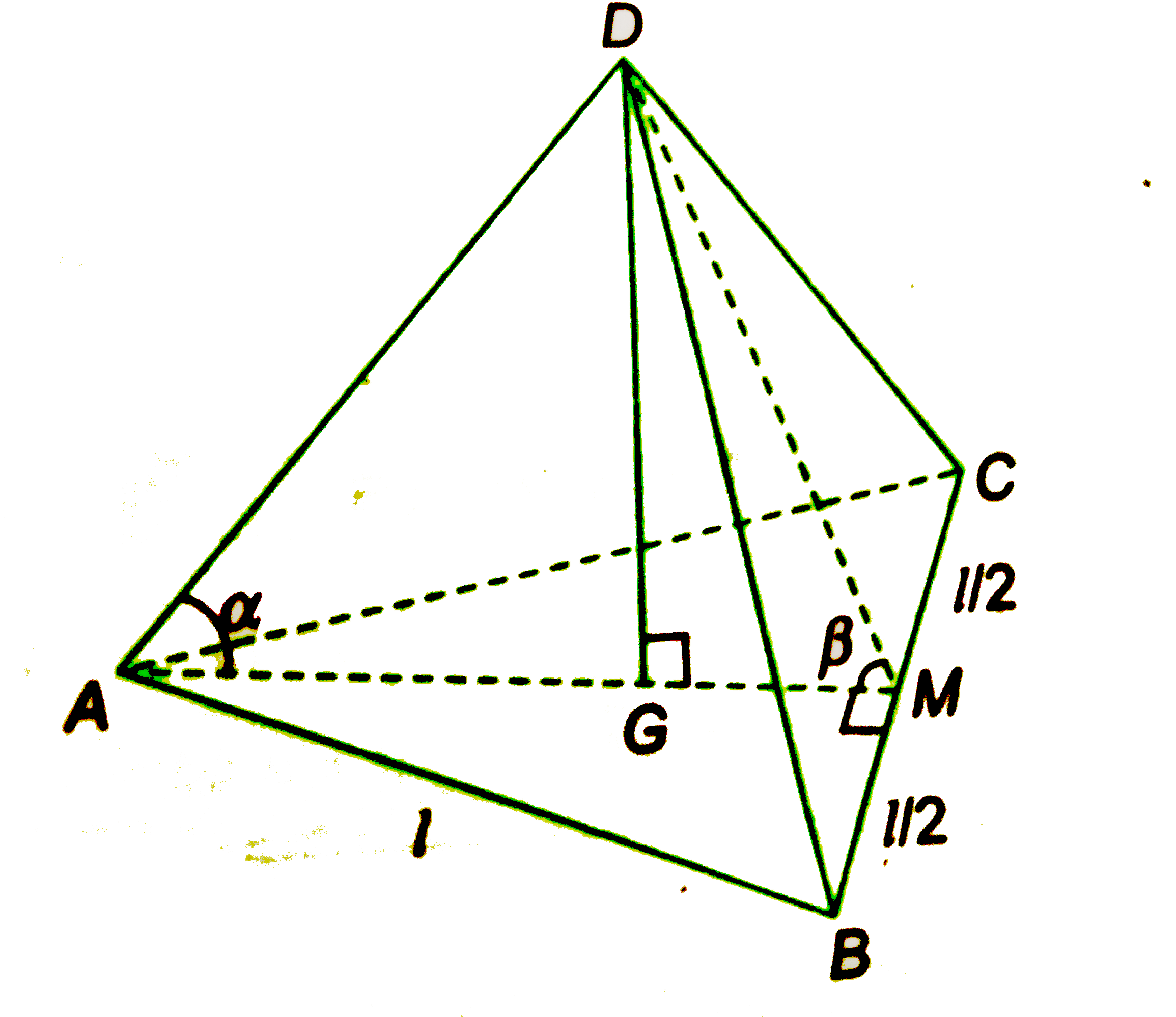find the height of the regular pyramid with each edge measuring l cm.
Also,
(i) if α is angle between any edge and face not containing that edge, then prove that cosα=1√3
(ii) if β is the between the two faces, then prove that cosβ=13
In the figure we have regular pyramid.

All the edges have length l cm.
So, each face of the pyramid is an equilateral triangle.
From vertex D drop perpendicular to meet opposite face ABC at point G, which is the centre of the triangle ABC.
Here, G is also centroid of triangle ABC as it an equailateral triangle.
Clearly, AG=23AM
In triangle AMB,AM=ABsin60∘=√32lcm
∴AG=23×AM=23×√32l=12√3lcm
In triangle AGD, using Pythagoras, we get
AD2=AG2+GD2
∴l2=13l2+GD2
∴GD=√231cm
For angle between any edge and face not containing that edge, consider edge AD and face ABC.
Angle between them is α,which is angle between AD and AM.
In triangle AGD, cosα=AGAD=1√3ll=1√3
Angle between two faces ABC and BCD is the angle between AM and DM, which is β.
In triangle DGM,cosβ=GMDM=13
Topper's Solved these Questions
- TRIGONOMETRIC FUNCTIONS BOOK - CENGAGE ENGLISHCHAPTER - TRIGONOMETRIC FUNCTIONS EXERCISE - example
10 Videos
- TRIGONOMETRIC FUNCTIONS BOOK - CENGAGE ENGLISHCHAPTER - TRIGONOMETRIC FUNCTIONS EXERCISE - Concept Application Exercises 2.1
8 Videos
- TRIGONOMETRIC EQUATIONSBOOK - CENGAGE ENGLISHCHAPTER - TRIGONOMETRIC EQUATIONSEXERCISE - Archives (Matrix Match Type)
1 Videos
- TRIGONOMETRIC RATIOS AND TRANSFORMATION FORMULASBOOK - CENGAGE ENGLISHCHAPTER - TRIGONOMETRIC RATIOS AND TRANSFORMATION FORMULASEXERCISE - Matrix Match Type
1 Videos
Similar Questions
In a regular tetrahedron, prove that angle θ between any edge and the face not containing that edge is given by cosθ=1√3.
View SolutionIn a regular tetrahedron, let θ be angle between any edge and a face not containing the edge. Then the value of cos2θ is
View SolutionFind the number of sides in a regular polygon, if its each exterior angle is :
(i)13 of a right angle
(ii) two-fifths of a right angle
View SolutionLet k be the length of any edge of a regular tetrahedron (a tetrahedron whose edges are equal in length is called a regular tetrahedron). Show that the angel between any edge and a face not containing the edge iscos−1(1/√3) .
View SolutionLet k be the length of any edge of a regular tetrahedron (a tetrahedron whose edges are equal in length is called a regular tetrahedron). Show that the angel between any edge and a face not containing the edge iscos−1(1/√3) .
View SolutionIf an angle α be divided into two parts such that the ratio of tangents of the parts is K. If x be the difference between the two parts , then prove that sinx=K−1K+1sinα.
View SolutionComprehesion-I
Let k be the length of any edge of a regular tetrahedron (all edges are equal in length). The angle between a line and a plane is equal to the complement of the angle between the line and the normal to the plane whereas the angle between two plane is equal to the angle between the normals. Let O be the origin and A,B and C vertices with position vectors →a,→b and →c respectively of the regular tetrahedron.
The angle between any edge and a face not containing the edge is
View SolutionComprehesion-I
Let k be the length of any edge of a regular tetrahedron (all edges are equal in length). The angle between a line and a plane is equal to the complement of the angle between the line and the normal to the plane whereas the angle between two plane is equal to the angle between the normals. Let O be the origin and A,B and C vertices with position vectors →a,→b and →c respectively of the regular tetrahedron.
The angle between any two faces is
View SolutionComprehesion-I
Let k be the length of any edge of a regular tetrahedron (all edges are equal in length). The angle between a line and a plane is equal to the complement of the angle between the line and the normal to the plane whereas the angle between two plane is equal to the angle between the normals. Let O be the origin and A,B and C vertices with position vectors →a,→b and →c respectively of the regular tetrahedron.
The value of [→a→b→c]2 is
View Solution(i) Find the angle bewteen the lines whose direction ratios are 1, 2, 3 and - 3 , 2 , 1
(ii) Find the angle between two diagonals of a cube.
View Solution
